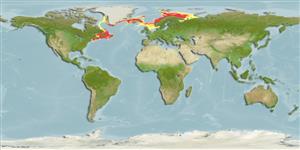Classificação / Names
Common names from other countries
Referência principal
Tamanho / Peso / Idade
Max length : 120 cm TL macho/indeterminado; (Ref. 9988); common length : 50.0 cm TL macho/indeterminado; (Ref. 1371); Peso máx. publicado: 30.0 kg (Ref. 9988); Idade máx. registada: 20 anos (Ref. 1371)
Length at first maturity
Lm 50.0, range 50 - ? cm
Ambiente
; marinhas demersal; oceanódromo (Ref. 51243); intervalo de profundidade 18 - 1000 m (Ref. 1371), usually 18 - 549 m (Ref. 1371)
Clima / Intervalo
Temperate, preferred 10°C (Ref. 107945); 83°N - 37°N, 75°W - 57°E (Ref. 1371)
Distribuição
Northwest Atlantic: New Jersey to the Strait of Belle Isle and on the Grand Banks of Newfoundland. Rare at the southern tip of Greenland. Northeast Atlantic: off Iceland, in the northern North Sea, and along the coast of Scandinavia to the Murmansk Coast and at Spitzbergen.
Países | Áreas FAO | Ecossistemas | Ocorrências | Introduções
Descrição breve
Espinhos dorsais (total): 0; Raios dorsais moles (total): 93-103; Raios anais moles: 62 - 75; Vértebras: 64 - 67. Barbel on present on chin, none on snout, its length equal to eye diameter. Color is variable; dorsally dark red-brown or green brown to yellow shading into pale color on belly. Young specimens may have six transverse yellow bands on sides. Vertical fins with dark margin rimmed with white.
Categoria na Lista Vermelha da IUCN (Ref. 115185)
Ameaça para o homem
Harmless
Utilização humana
Pescarias: altamente comercial; peixe desportivo: sim
Mais informação
ReferênciasAquaculturaPerfil para aquaculturaEstirpesGenéticaFrequência dos alelosHereditariedadeDoençasProcessamentoMass conversion
Ferramentas
Relatórios especiais
Descarregue XML
Fontes da internet
Estimates of some properties based on models
Phylogenetic diversity index
PD50 = 1.0000 many relatives (e.g. carps) 0.5 - 2.0 few relatives (e.g. lungfishes)
Nível Trófico
3.9 ±0.3 se; Based on diet studies.
Resiliência
Baixo, tempo mínimo de duplicação da população 4,5 - 14 anos (K=0.08-0.16; tm=8-10; tmax=20; Fec=2 million)
Vulnerabilidade
High vulnerability (63 of 100)
Categoria de preço
